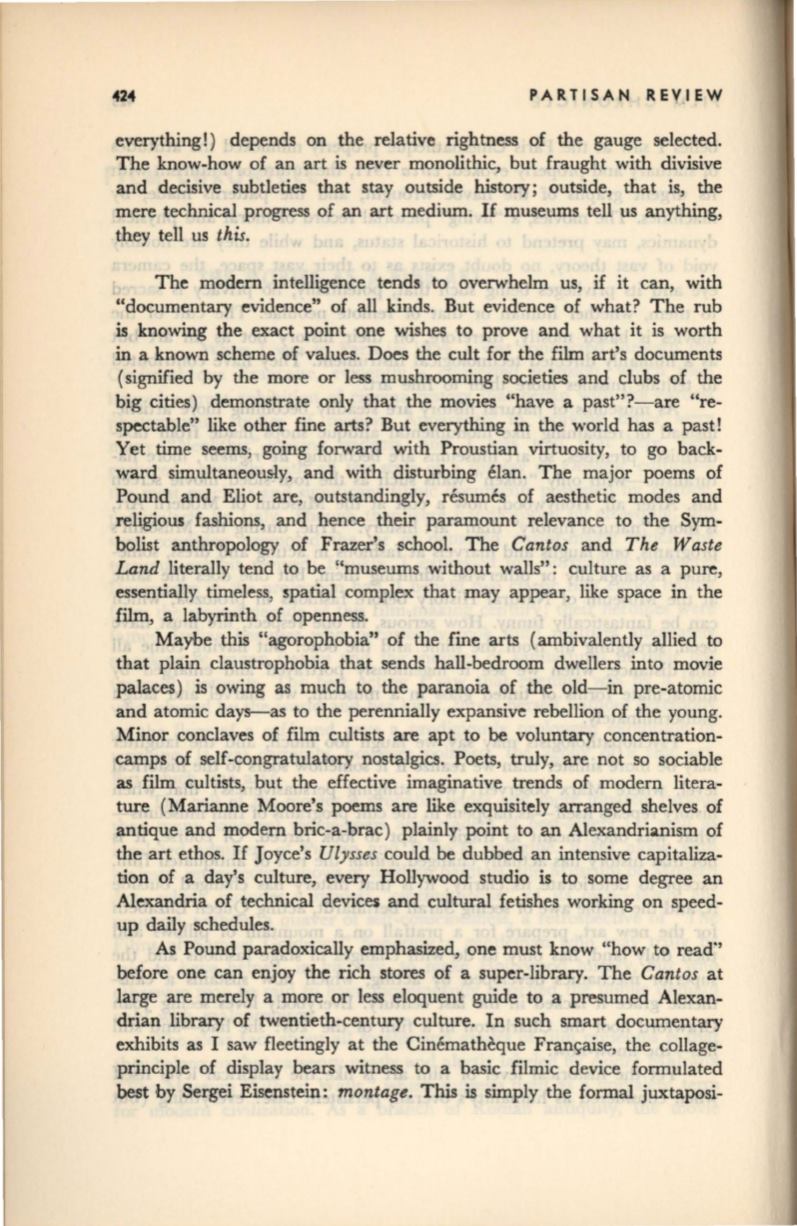
..2..
PAR TIS AN REV.I EW
everything!) depends on the relative rightness of the gauge selected.
The know-how of an art is never monolithic, but fraught with divisive
and decisive subtleties that stay outside history; outside, that is, the
mere technical progress of an art medium.
If
museums tell us anything,
they tell us
this.
The modern intelligence tends to overwhelm us, if it can, with
"documentary evidence" of all kinds. But evidence of what? The rub
is knowing the exact point one wishes to prove and what it is worth
in a known scheme of values. Does the cult for the film art's documents
(signified by the more or less mushrooming societies and clubs of the
big cities) demonstrate only that the movies "have a past"?-are "re–
spectable" like other fine arts? But everything in the world has a past!
Yet time seems, going forward with Proustian virtuosity, to go back–
ward simultaneously, and with disturbing elan. The major poems of
Pound and Eliot are, outstandingly, resumes of aesthetic modes and
religious fashions, and hence their paramount relevance to the Sym–
bolist anthropology of Frazer's school. The
Cantos
and
The Waste
Land
literally tend to be "museums without walls": culture as a pure,
essentially timeless, spatial complex that may appear, like space in the
film, a labyrinth of openness.
Maybe this "agorophobia" of the fine arts (ambivalently allied to
that plain claustrophobia that sends hall-bedroom dwellers into movie
palaces) is owing as much to the paranoia of the old-in pre-atomic
and atomic days-as to the perennially expansive rebellion of the young.
Minor conclaves of film cultists are apt to be voluntary concentration–
camps of self-congratulatory nostalgics. Poets, truly, are not so sociable
as film cultists, but the effective imaginative trends of modern litera–
ture (Marianne Moore's poems are like exquisitely arranged shelves of
antique and modern bric-a-brac) plainly point to an Alexandrianism of
the art ethos.
If
Joyce's
Ulysses
could be dubbed an intensive capitaliza–
tion of a day's culture, every Hollywood studio is to some degree an
Alexandria of technical devices and cultural fetishes working on speed–
up daily schedules.
As Pound paradoxically emphasized, one must know "how to read"
before one can enjoy the rich stores of a super-library. The
Cantos
at
large are merely a more or less eloquent guide to a presumed Alexan–
drian library of twentieth-century culture. In such smart documentary
exhibits as I saw fleetingly at the Cinematheque
Fran~aise,
the collage–
principle of display bears witness to a basic filmic device formulated
best
by Sergei Eisenstein:
montage.
This
is
simply the formal juxtaposi-


